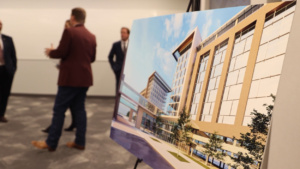 Texas A&M-Fort Worth Moving Quickly Toward
Texas A&M-Fort Worth Moving Quickly Toward
Construction of Urban Research Campus
Information + Image courtesy of TAMUS
The Texas A&M University System’s downtown research campus, officially named Texas A&M-Fort Worth, is moving quickly toward construction as the anchor project for a technology and innovation district planned around the redevelopment of the city’s convention center.
The three-building complex, to be built on four blocks at the site of the Texas A&M School of Law, will provide a range of programs offered by Texas A&M University, Tarleton State University, and several A&M System agencies.
On Thursday, Chancellor John Sharp and a team of university and agency leaders briefed the news media and an audience of supporters at the A&M System’s temporary offices in Burnett Plaza. Sharp also introduced the team of architects and construction managers who have been selected to begin construction later this summer on its first building, the Law & Education Building.
“A top-10 public research institution ensures Fort Worth’s future is rooted in the next economy driven by an educated workforce, whether it be lawyers, engineers, health care professionals or technology workers whose jobs don’t even exist today,” said Chancellor Sharp. “Thanks to our partners, the city of Fort Worth and Tarrant County, the Texas A&M System is investing in a unique public-private sector endeavor that will be a magnet for economic growth for the North Texas region.”
Two years ago, Fort Worth and Tarrant County officials, along with representatives of the business community, invited the Texas A&M System to bring its research and academic prowess to the city. Fort Worth is the largest Texas city without a significant presence by a large public research university.
The high-rise complex will include classrooms, labs, and flexible research and maker spaces that can be used by the public and private sectors for academic programs, workforce training and collaborative research in the fields of engineering, emergency management communications, agriculture, health sciences and visualization, among others.
The Texas A&M System will construct the Law & Education Building, which is expected to be completed in 2025. It will be financed with bonds backed by the Permanent University Fund and other sources.
The other two facilities, the Research and Innovation building and the Gateway conference center and offices, will be financed with city-issued bonds secured by leases to the A&M System and private sector development firms.
A developer, who is yet to be chosen, will be responsible for developing and leasing the space for the private firms. Start dates for the two buildings have not been announced.
This unique financing system will allow the campus to be constructed in about a third of the 15 years it would take for the A&M System to do it alone.
Once completed, this innovation and technology hub will allow research, workforce training and academic programs to be offered throughout the community as well as at the campus.
For example, the Texas A&M System already has master research agreements with several of Fort Worth’s larger employers.
Also, the Texas A&M College of Engineering has created an engineering academy at Tarrant County College where students can take two years of engineering courses taught by A&M professors before transferring to College Station. The academy allows students to save money by taking basic courses at the community college and living at home for the first two years of college.
At Thursday’s event, Chancellor Sharp also introduced the design team for the Law & Education Building: Stantec will serve as the architect of record and provide lab planning services on the project working in partnership with the design architect, Pelli Clarke & Partners.
“Our team is committed to designing high-performing, flexible spaces that meet the needs of modern education,” said Dan Caren, principal at Stantec. “We’re excited to work closely with Texas A&M, Pelli Clarke, and all the project stakeholders to create a future-focused learning environment that will help students grow and become experts in their professional fields.”
William Butler, Design Partner at Pelli Clarke & Partners, said, “Aside from providing a state-of-the-art space for education, collaboration, and innovation, the Texas A&M Fort Worth Law and Education building will serve as a catalyst for Downtown Fort Worth’s next chapter.”
The construction management teams consists of Turner Construction Company, CARCON Industries, Source Building Group Inc., and Dikita Enterprises.
“Turner and our partners look forward to partnering with the Texas A&M System in supporting your effort to develop the plan and vision for the Fort Worth campus while utilizing our team’s full resources and proven best practices to maximize opportunities for HUBs and local Fort Worth trade contractors,” said Andy Tandon, Vice President & General Manager for Turner Construction.
About The Texas A&M University System The Texas A&M University System is one of the largest systems of higher education in the nation, with a budget of $7.2 billion. Through a statewide network of 11 universities, a comprehensive health science center, eight state agencies, and the RELLIS Campus, the Texas A&M System educates more than 152,000 students and makes more than 24 million additional educational contacts through service and outreach programs each year. System-wide, research and development expenditures exceed $1 billion and help drive the state’s economy.